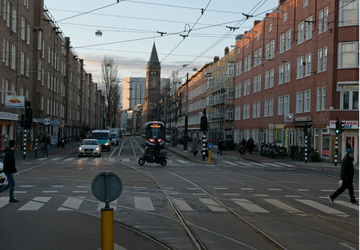What Factors are Driving Americans to Move from Cities to Suburbs?
Have you ever wondered the reason behind the Americans moving from city apartments to the suburban homes? This city-to-suburb migration is more than just a passing trend—it's a significant shift in how Americans choose to live. Driven by a desire for more space, a better quality of life, and other compelling reasons, the move from urban centers to suburban neighborhoods is transforming communities nationwide.
Have you ever wondered the reason behind the Americans moving from city apartments to the suburban homes? This city-to-suburb migration is more than just a passing trend—it's a significant shift in how Americans choose to live. Driven by a desire for more space, a better quality of life, and other compelling reasons, the move from urban centers to suburban neighborhoods is transforming communities nationwide.
Let's discuss the reasons for moving to the suburbs and discover why suburbia is becoming the new American dream!

The Appeal of Suburban Living
More Space and Privacy
One of the primary reasons Americans are leaving city life behind is the promise of more space. In urban environments, space is often a luxury. Apartments and condos are typically smaller, and outdoor space is limited to small balconies or shared courtyards. In contrast, suburban homes often feature larger properties, including expansive lawns and private backyards. This additional space is particularly attractive to families, offering room for children to play, gardens to cultivate, and even home offices or personal retreats.
Quality of Life
Suburban areas are frequently associated with a higher quality of life compared to their urban counterparts. The cost of living in the suburbs is often lower, which translates to more affordable housing, lower property taxes, and reduced expenses for goods and services. Suburbs generally offer a more relaxed atmosphere with less noise and pollution, contributing to improved mental and physical health. The lower crime rates typical of suburban areas enhance residents' sense of safety and security, further boosting overall quality of life.
Economic Factors
Affordability
One of the driving forces behind the move to the suburbs is affordability. Urban housing markets can be prohibitively expensive, with high prices for both rental and owned properties. The cost of living in cities is also high due to increased prices for groceries, services, and transportation. Suburbs often offer a more budget-friendly alternative, where buyers can purchase larger homes with more amenities at a fraction of the cost of city properties.
For renters, suburban areas provide more space and better living conditions without the exorbitant rent prices found in cities. This affordability allows residents to allocate their finances towards savings, investments, and leisure activities, enhancing their overall financial well-being.
Remote Work and Flexibility
The rise of remote work has majorly influenced the migration from urban to suburban areas. With the advent of technology and changes in work culture, many jobs no longer require a daily commute to an office. This flexibility has made it easier for individuals to live further from their workplace without sacrificing their careers. The COVID-19 pandemic accelerated this shift, demonstrating that remote work can be both productive and effective. As a result, people are choosing to move to suburban areas where they can enjoy more spacious and comfortable living conditions while maintaining their professional responsibilities.
Family and Community
Education and Schools
Education alone is a major factor driving families to the suburbs. Many suburban areas boast highly regarded school districts with better funding, smaller class sizes, and a wider range of extracurricular activities. Parents often seek out these communities to provide their children with a strong educational foundation and ample growth opportunities. Suburban schools are frequently equipped with modern facilities and resources that enhance the learning experience. This emphasis on education, combined with a supportive community, helps foster a nurturing environment for children, contributing to their academic success and personal development.
Community Amenities
Suburbs are known for their family-friendly amenities and a strong sense of community. Many suburban neighborhoods feature well-maintained parks, community centers, and recreational facilities such as swimming pools and sports fields. These amenities provide residents with opportunities for leisure, exercise, and social interaction. Suburban areas often host community events, farmers' markets, and local festivals, creating a vibrant and connected atmosphere.
Urban Challenges
City Stressors
Urban living comes with its own set of challenges that can drive people to seek a more peaceful suburban life. High living costs are a significant stressor, with expenses for housing, transportation, and daily necessities often surpassing those in suburban areas. Overcrowding is another common issue, leading to long commutes, traffic congestion, and a constant hustle and bustle. The fast-paced nature of city life can be overwhelming, and the noise and pollution contribute to a high-stress environment.
Lifestyle Preferences
Lifestyle preferences play a vital role in the decision to move from the city to the suburbs. Many individuals and families are drawn to the slower pace and greater tranquility that suburban life offers. The city’s frenetic energy and constant activity can be exhausting, leading people to seek the peace and stability of suburban living. The suburbs provide a more relaxed atmosphere with less noise, fewer crowds, and a greater emphasis on community and family life. This shift in lifestyle preferences reflects a desire for a more harmonious and less hectic way of living.
Environmental and Health Considerations

Green Spaces
Suburban areas often feature more green spaces compared to cities. Parks, nature reserves, and green belts are common in suburban neighborhoods, providing residents with easy access to nature. These green spaces offer opportunities for outdoor activities such as hiking, biking, and picnicking. Proximity to nature has been shown to have numerous benefits, including reduced stress levels, improved mood, and better physical health. The abundance of green areas in the suburbs contributes to a healthier living environment.
Health Benefits
The health benefits of suburban living are significant. The reduced noise levels and lower pollution in suburban areas contribute to better mental and physical health. Residents often experience lower stress levels and improved overall well-being. The availability of outdoor recreational spaces encourages physical activity, which is necessary for maintaining good health. Suburban environments also have a stronger emphasis on family and community, which supports networks that are beneficial for mental health. The combination of these factors makes suburban living a healthier choice for many people.
Conclusion
The rise in urban-to-suburban trends reflects a broader desire for space, affordability, and a higher quality of life. As people prioritize family, community, and well-being, the suburbs increasingly offer a desirable alternative to urban pressures. This transformation is shaping new patterns of living and redefining what it means to find a place to call home.